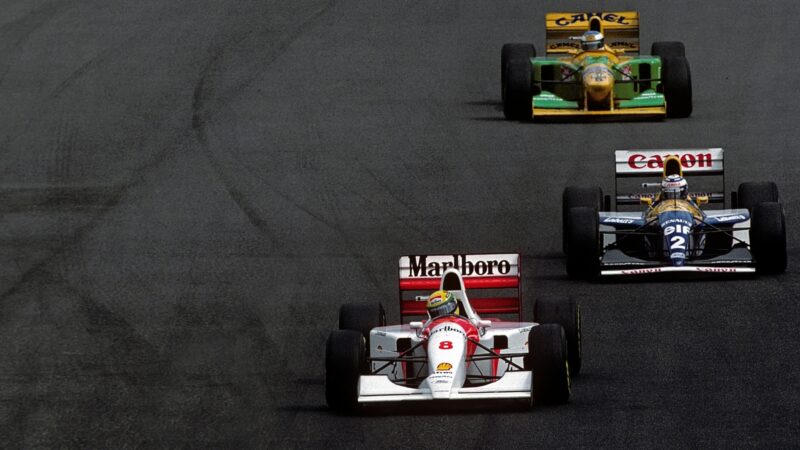F1 data ranks Senna as fastest driver of the past 40 years
Data has been used to determine the fastest 20 drivers from the past 40 years in Formula 1 over the course of a single flying lap

Ayrton Senna, Michael Schumacher and Alain Prost all make the list, but not everyone makes the top 10
Paul-Henri Cahier/Getty Images
The debate used to be fuelled by beer and crisps; now analysis and an algorithm has been used in an attempt to identify Formula 1’s fastest driver of the past 40 years.
Qualifying statistics from the past 40 years were fed into Amazon’s machine learning software; outliers were banished, data normalised and a “complex network of drivers’ performance” was built to conclude that Ayrton Senna is the quickest driver on a single lap since 1983.
The analysis focused on a driver’s performance against their team-mates to strip out the effect of differing car performance, apparently settling the argument over one of F1’s great duels: Alain Prost is placed 20th in the table.
Senna claimed a record 65 pole positions during his career; a record which has since been overtaken by the two drivers that sit below him in the new performance table.
Michael Schumacher was ranked as runner-up, the software suggesting that he would set a time 0.114sec behind Senna, given the same car on the same lap of a hypothetical circuit. Lewis Hamilton placed third, 0.275sec down on his idol.
While the top three of Senna, Schumacher and Hamilton should not surprise anyone, the inclusion of a few names might raise an eyebrow or two.
| Ranking | Driver | Time delta |
| 1 | Ayrton Senna | 0.000sec |
| 2 | Michael Schumacher | 0.114sec |
| 3 | Lewis Hamilton | 0.275sec |
| 4 | Max Verstappen | 0.280sec |
| 5 | Fernando Alonso | 0.309sec |
| 6 | Nico Rosberg | 0.374sec |
| 7 | Charles Leclerc | 0.376sec |
| 8 | Heikki Kovalainen | 0.378sec |
| 9 | Jarno Trulli | 0.409sec |
| 10 | Sebastian Vettel | 0.435sec |
| 11 | Rubens Barrichello | 0.445sec |
| 12 | Nico Hulkenberg | 0.456sec |
| 13 | Valtteri Bottas | 0.457sec |
| 14 | Carlos Sainz | 0.457sec |
| 15 | Lando Norris | 0.459sec |
| 16 | Daniel Ricciardo | 0.461sec |
| 17 | Jenson Button | 0.462sec |
| 18 | Robert Kubica | 0.463sec |
| 19 | Giancarlo Fisichella | 0.469sec |
| 20 | Alain Prost | 0.514sec |
The top five is completed by Max Verstappen and Fernando Alonso while the lower reaches of the top 10 is where the rankings get interesting.
Heikki Kovalainen, team-mates to Hamilton at McLaren between 2008-09 and later Lotus/Caterham driver makes a surprise appearance in eighth while Jarno Trulli comes in ahead of Sebastian Vettel to nab the final top 10 spot.
Eight current drivers are included in the list, with Valtteri Bottas, Carlos Sainz, Lando Norris and Daniel Ricciardo ranking from 13th to 16th respectively with Charles Leclerc ranking seventh.
Alonso’s Renault team-mate from 2005-06 Giancarlo Fisichella sneaks into the top 20 ahead of four-time world champion Alain Prost – the Frenchman fifth in the rankings for all-time pole positions with 33.
F1 insights provided by Amazon Web Services (AWS) have been frequently included in broadcasts this season to compare driver performances from a data-driven perspective, and the algorithm used to build this ranking took a year to develop.
F1’s director of data systems Rob Smedley collaborated with AWS to set the criteria. Team-mates had to have competed in at least five qualifying sessions for their data to be compared, and the results were weighted to take age into account, along with experience — results were adjusted for drivers returning after three or more seasons out of the sport.
Outliers such as crashes, car failures and changeable weather conditions have been taken out of the data pool in the interest of fairness.
“Qualifying speed is something that we can be really quite clear about,” says Rob Smedley.
“If you think about race pace, there’s a lot of nuances to that race pace, and it’s sometimes difficult to pull it out. A qualifying lap is a single lap, you’ve got two guys in the same car and they go out and do a single lap, and the better driver will end up with the better lap.
“There’s not much ambiguity about that single data point, so that’s the data point that we’re using. What we have to do as the mathematical modellers is to look at what data is available and then ensure that we can normalise that data across the years.
“The model is then clever enough to reconcile the rest by just understanding what the lap times are. So it would seem that you’d need a load of data and… a load of car data and all the rest of it, but you don’t. It’s simply just using the lap times, and… we’ve got robust data, in terms of lap times, from this period.”
Whether this settles the question of the greatest Formula 1 driver is another matter. A statistical analysis published in 2016, in conjunction with the University of Sheffield placed Prost and Alonso ahead of Senna — along with Juan Manuel Fangio and Jim Clark, who weren’t considered by the latest F1 analysis. And it’s safe to say that there are plenty of other differing opinions.
